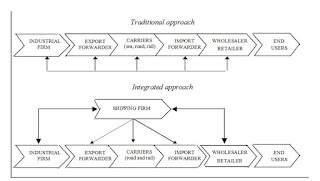 Containerization
has gradually led to the commoditization
of the ocean liner service and thus to higher competition among carriers. In an
effort to differentiate their service, as well as better control the supply
chain, in the 1990s carriers started to invest in the other components of the
supply chain, such as container terminals, distribution centers, road, rail and
air transport, and in a miscellany of other logistics services, such as
bar-coding, assembly, documentation, etc.
Investment in logistics services and related infrastructure, rather than
in ships, -which, incidentally, could be chartered-in from private equity
investors (e.g. KG funds in Germany)- allowed the carrier to become more asset light, thus more agile in coping
with the vagaries of the business cycle.
In addition to service differentiation, vertical integration also serves in increasing both the complexity of operations and the sunk costs of aspiring new competitors (carriers) , particularly if
shippers are convinced, through effective marketing, that an integrated service
is the only way to better serve their requirements.
Containerization
has gradually led to the commoditization
of the ocean liner service and thus to higher competition among carriers. In an
effort to differentiate their service, as well as better control the supply
chain, in the 1990s carriers started to invest in the other components of the
supply chain, such as container terminals, distribution centers, road, rail and
air transport, and in a miscellany of other logistics services, such as
bar-coding, assembly, documentation, etc.
Investment in logistics services and related infrastructure, rather than
in ships, -which, incidentally, could be chartered-in from private equity
investors (e.g. KG funds in Germany)- allowed the carrier to become more asset light, thus more agile in coping
with the vagaries of the business cycle.
In addition to service differentiation, vertical integration also serves in increasing both the complexity of operations and the sunk costs of aspiring new competitors (carriers) , particularly if
shippers are convinced, through effective marketing, that an integrated service
is the only way to better serve their requirements.
This
situation has started to change. Carriers appear to be returning back to core
business, shedding the idea of vertical integration in favor of better
horizontal integration (alliances) and dominance in the sector (shipping) where
they have the comparative advantage. Partly, this return
to roots has been the result of the weakening or banning of liner conferences,
and the low freight rates and service unreliability that have ensued. Presently,
you can bring a container from Hong Kong to Rotterdam with $300; far below
break-even point. Laid up container tonnage is 5% of the total fleet (over one
million slots) and, interestingly, it is often the largest and newest ships, such
as MSC Oscar, which are laid up. To no avail, consignees are desperately
looking for someone to talk to on the phone. In complex ports like Los Angeles,
the terminal of arrival is often unknown until the last minute. At the other
end, in Asia, to be filled, a mega ship would call at far more ports than what
its size would warrant; something creating a stowage nightmare at the receiving
ports. In short, you have a ghastly mess,[1] brought about by the shippers themselves. HH
[1] Lyrics
from “The life I Lead” (Mary Poppins) […] A British bank is run with precision.
A British home requires nothing less. Tradition, discipline and rules must be
the tools; without them: disorder, catastrophe, anarchy, in short you have a
ghastly mess.
No comments:
Post a Comment